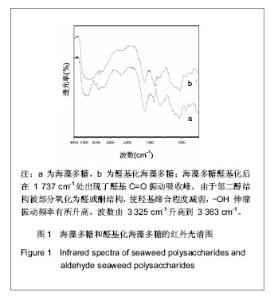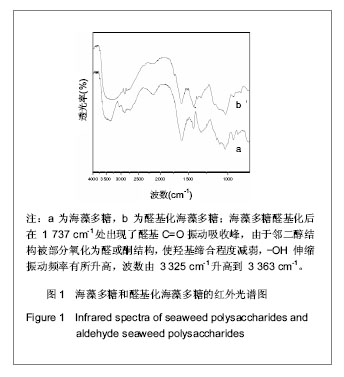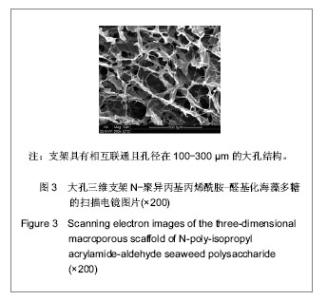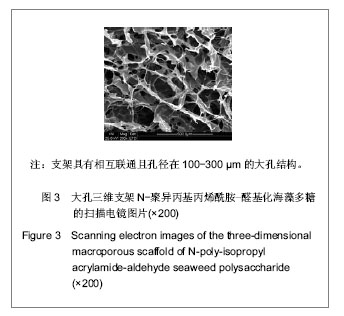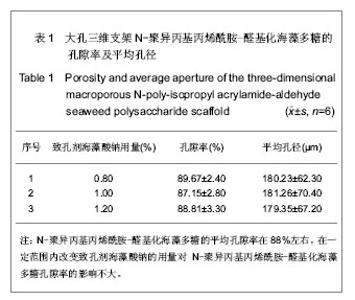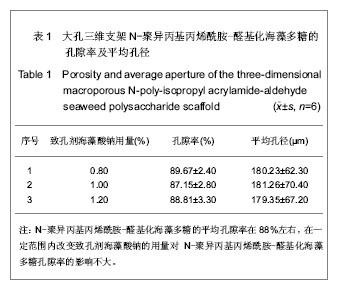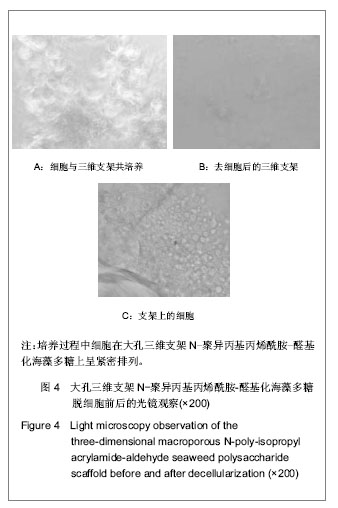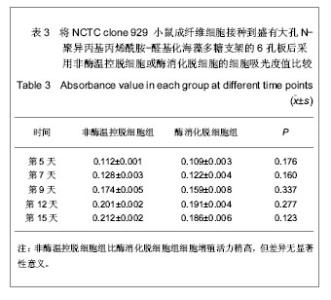Chinese Journal of Tissue Engineering Research ›› 2013, Vol. 17 ›› Issue (25): 4660-4667.doi: 10.3969/j.issn.2095-4344.2013.25.014
Previous Articles Next Articles
Aldehyde seaweed polysaccharide composites serve as artificial liver carriers
Yu Mei-li, Du Zhi, Han Tao, Wang Ya-rong, Chen Jing, Guo Hong-yue, Li Nan, An Shuai-xing
- Tianjin Artificial Cell Key Laboratory, the Third Center Hospital of Tianjin, Tianjin 300170, China
-
Received:2012-12-18Revised:2013-03-27Online:2013-06-18Published:2013-06-18 -
Contact:Du Zhi, Professor, Tianjin Artificial Cell Key Laboratory, the Third Center Hospital of Tianjin, Tianjin 300170, China tjsdszxyyyjs@163.com -
About author:Yu Mei-li, Researcher, Tianjin Artificial Cell Key Laboratory, the Third Center Hospital of Tianjin, Tianjin 300170, China yumeili8@163.com -
Supported by:the Applied Basic Research Foundation of Tianjin Municipal Science and Technology Commission, No. 11JCYBJC27700; the Science and Technology Foundation of Tianjin Health Bureau, No. 2011KR06
CLC Number:
Cite this article
Yu Mei-li, Du Zhi, Han Tao, Wang Ya-rong, Chen Jing, Guo Hong-yue, Li Nan, An Shuai-xing. Aldehyde seaweed polysaccharide composites serve as artificial liver carriers [J]. Chinese Journal of Tissue Engineering Research, 2013, 17(25): 4660-4667.
share this article
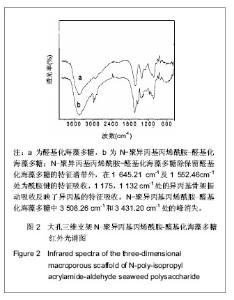
海藻多糖醛基化后在1 737 cm-1处出现了醛基C=O振动吸收峰。由于邻二醇结构被部分氧化为醛或酮结构,使羟基缔合程度减弱。结果显示,-OH伸缩振动频率有所升高,波数由3 325 cm-1升高到3 363 cm-1。因此,通过红外谱图分析,可以看出海藻多糖经过高碘酸钠氧化后确实生成了醛基。 图2为大孔三维支架PNIPA-Am-OSA及OSA红外谱图,PNIPA-Am-OSA除保留OSA的特征谱带外,在 1 645.21 cm-1及1 552.46 cm-1处为酰胺键的特征吸收,1 175,1 132 cm-1处的异丙基骨架振动吸收反映了异丙基的特征吸收;PNIPA-Am-OSA中3 508.26 cm-1和 3 431.20 cm-1处的峰消失,表明-NHNH2基团参与了反应;红外分析结果证明PNIPA-AM共聚物与OSA 反应,-NHNH2与-CHO脱水形成席夫碱。"
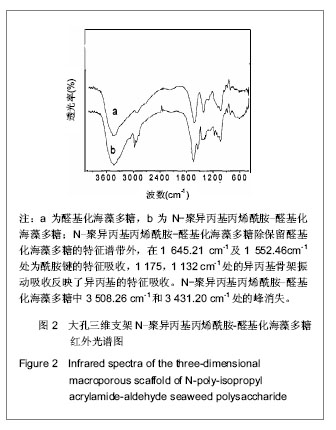
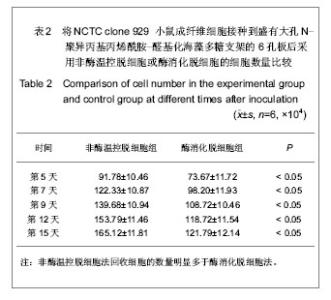
结果显示,大孔三维支架的平均孔隙率在88%左右,在一定范围内改变致孔剂海藻酸钠的用量对其影响不大。作为大孔三维支架材料,其孔隙率和平均孔径相对比较大,可以满足细胞所需的营养物质的输送及代谢产物排放的要求。 2.4 大孔三维支架PNIPA-Am-OSA的细胞毒性 MTT检测结果显示,大孔三维支架PNIPA-Am-OSA样品提取液组ATCC CCL1细胞的相对增殖率在 89%以上,没有表现出细胞毒性;用 DMEM 浸泡处理3次(10 min/次)后, ATCC CCL1细胞的相对增殖率达到98%,证明大孔三维支架PNIPA-Am-OSA生物相容性良好。 2.5 大孔三维支架PNIPA-Am-OSA不同脱细胞方法的比较结果 实验组与对照组不同时间收获细胞数量比较,见表2。"
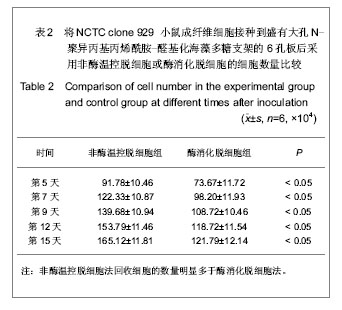
| [1] Cao Y,Zhang C,Shen W,et al. Poly(N-isopropylacrylamide)-chitosan as thermosensitive in situ gel-forming system for ocular drug delivery.J Controlled Release.2007;120(3): 186-194.[2] Yamada N,Okano T,Sakai H,et al.Thermo-responsive polymeric surfaces; control of attachment and detachment of cultured cells.Makromol Chem Rapid Comm.1990;11(11): 571-576.[3] Dang QF,Yan JQ,Li JJ,et al.Controlled gelation temperature, pore diameter and degradation of a highly porous chitosan-based hydrogel.Carbohydrate Polymers.2011;83(1): 171-178.[4] Chen J,Liu M,Liu H,et al. Synthesis, swelling and drug release behavior of poly(N,N-diethylacrylamide-co-N-hydroxymethyl acrylamide) hydrogel.Mater Sci Eng C.2009;29(7):2116-2123.[5] Wang L,Stegemann JP.Thermogelling chitosan and collagen composite hydrogels initiated with beta-glycerophosphate for bone tissue engineering. Biomaterials.2010;31(14):3976-3985.[6] Okano T,Yamada N,Sakai H,et al.A novel recovery system for cultured cells using plasma-treated polystyrene dishes grafted with poly(N-isopropylacrylamide). J Biomed Mater Res.1993; 27(10): 1243-1251.[7] Zhang GQ,Zha LS,Liang BR.Gaofenzi Xuebao. 2009;53(7): 633-636.张高奇,查刘生,梁伯润.在NaCl溶液中以海藻酸钠为致孔剂制备快速温度响应型多孔聚(N-异丙基丙烯酰胺)水凝胶[J].高分子学报,2009,53(7):633-636.[8] Ducatti DR,Massi A,Noseda MD,et al. Production of carbohydrate building blocks from red seaweed polysaccharides. Efficient conversion of galactans into C-glycosyl aldehydes.Org Biomol Chem.2009;7(3):576-588. [9] He SL,Zhang M,Geng ZJ,et al.Yingyong Huaxue. 2005;22(9): 1007-1011.何淑兰,张 敏,耿占杰,等.部分氧化海藻酸钠的制备与性能[J].应 用化学,2005,22(9):1007-1011.[10] Gao C,Liu M,Chen J,et al.Interactions between bovine serum albumin and oxidized sodium alginate in solution.J Biomater Sci Polym Ed. 2011;22(12):1639-1650.[11] Chen Y,Qian H,Zhu W,et al. Hepatocyte growth factor modification promotes the amelioration effects of human umbilical cord mesenchymal stem cells on rat acute kidney injury.Stem Cells Dev.2011; 20(1): 103-113.[12] Yan Y,Xu W,Qian H,et al.Mesenchymal stem cells from human umbilical cords ameliorate mouse hepatic injury in vivo. Liver Int.2009;29(3): 356-365.[13] Jung KH,Shin HP,Lee S,et al. Effect of human umbilical cord blood-derived mesenchymal stem cells in a cirrhotic rat model.Liver Int.2009;29(6): 898-909.[14] Hirschfield GM,Gibbs P,Griffiths WJ.Adult liver transplantation: what non-specialists need to know.BMJ.2009;338: b1670.[15] Lu YB,Qiu F,Chen YZ,et al.Shengwu Gongcheng Xuebao. 2009;25(4): 599-604.卢永波,邱峰,陈咏竹,等.大鼠脂肪间充质干细胞诱导为类肝细胞及其细胞片的制备[J].生物工程学报,2009,25(4): 599-604.[16] Yu ML,Du Z,Zhu ZY,et al. Zhongguo Zuzhi Gongcheng Yanjiu yu Linchuang Kangfu. 2009;13(47):9302-9305.于美丽,杜智,朱争艳,等.人胎儿肝干细胞在聚酸酐-氨基葡聚糖三维载体内的生长活性[J].中国组织工程研究与临床康复,2009, 13(47):9302-9305.[17] Haraguchi K,Taniguchi S,Takehisa T.Reversible Force Generation in a Temperature Responsive Nanocomposite Hydrogel Consisting of Poly(N- isopropylacrylamide) and Clay.Chem Phys Chem.2005;6(2):238-241.[18] Haraguchi K,Takehisa T,Ebato M. Control of cell cultivation and cell sheet detachment on the surface of polymer/clay nanocomposite hydrogels. Biomacromolecules.2006; 7(11): 3267-3275.[19] Kato N,Sato S,Yamanaka A,et al.Silk protein, sericin, inhibits lipid peroxidation and tryosinase activity. Biosci Biotechnol Biochem.1998;62(1): 145-147.[20] Sasaki M,Kato N,Watanabe H,et al.Inhibitory effect of silk protein, sericin on swelling and ulcerating of mouse large intestine.Oncology Rep.2000;7: 1049-1053.[21] Ha S,Park YH,Hudson MS.Dissolution of Bombyx mori Silk Fibroin in the Calcium Nitrate Tetrahydrate-Methanol System and Aspects of Wet Spinning of Fibroin Solution. Biomacromolecules.2003;4(3):488-496.[22] Zhu LJ,Arai M,Hirabayashi K.Gelation of silk sericin and physical properties of the gel.J Seric Sci Jpn.1995;64(5): 415-419.[23] Moran EC,Baptista PM,Evans DW,et al.Evaluation of parenchymal fluid pressure in native and decellularized liver tissue. Biomed Sci Instrum. 2012;4(8):303-309.[24] Kasoju N, Bora U.Silk fibroin based biomimetic artificial extracellular matrix for hepatic tissue engineering applications. Biomed Mater. 2012; 7(4): 1045-1055. [25] Kasuya J,Sudo R,Tamogami R,et al.Reconstruction of 3D stacked hepatocyte tissues using degradable,microporous poly(d,l-lactide-co-glycolide) membranes.Biomaterials. 2012; 33(9):2693-2700.[26] Miyoshi H,Ehashi T,Kawai H,et al.Three-dimensional perfusion cultures of mouse and pig fetal liver cells in a packed-bed reactor: effect of medium flow rate on cell numbers and hepatic functions. J Biotechnol. 2010;148(4): 226-322. [27] Kiatkam jomwong S,Chomsakasakul W,Sonsuk M.Radiation modification of water absorption of cassava starch by acrylic acid/acrylamide.Radiat Phys Chem.2000;59(4):413-427.[28] Coughlan DC,Quilty FP,Corrigan OI.Effect of drug physicochemical properties on swelling/deswelling kinetics and pulsatile drug release from thermoresponsive poly(N-isopropylacrylamide) hydrogels.J Controlled Release. 2004;98(1):97-114. |
| [1] | Li Li, Ma Li. Immobilization of lactase on magnetic chitosan microspheres and its effect on enzymatic properties [J]. Chinese Journal of Tissue Engineering Research, 2021, 25(4): 576-581. |
| [2] | Zhou Anqi, Tang Yufei, Wu Bingfeng, Xiang Lin. Designing of periosteum tissue engineering: combination of generality and individuality [J]. Chinese Journal of Tissue Engineering Research, 2021, 25(22): 3551-3557. |
| [3] | Lang Limin, He Sheng, Jiang Zengyu, Hu Yiyi, Zhang Zhixing, Liang Minqian. Application progress of conductive composite materials in the field of tissue engineering treatment of myocardial infarction [J]. Chinese Journal of Tissue Engineering Research, 2021, 25(22): 3584-3590. |
| [4] | Xie Jian, Su Jiansheng. Advantages and characteristics of electrospun aligned nanofibers as scaffolds for tissue engineering [J]. Chinese Journal of Tissue Engineering Research, 2021, 25(16): 2575-2581. |
| [5] | Ji Qi, Yu Zhengwen, Zhang Jian. Problems and trends of technique and clinical application of metallic biomaterials prepared by three-dimensional printing technology [J]. Chinese Journal of Tissue Engineering Research, 2021, 25(16): 2597-2604. |
| [6] | Qian Nannan, Zhang Qian, Yang Rui, Ao Jun, Zhang Tao. Mesenchymal stem cells in the treatment of spinal cord injury: cell therapy and combination of new drugs and biomaterials [J]. Chinese Journal of Tissue Engineering Research, 2021, 25(13): 2114-2120. |
| [7] | Jia Wei, Zhang Mandong, Chen Weiyi, Wang Chenyan, Guo Yuan. Effects of femoral prosthetic materials on artificial knee arthroplasty performance [J]. Chinese Journal of Tissue Engineering Research, 2021, 25(10): 1477-1481. |
| [8] | Wang Qian, Li Lu, Shu Jingyuan, Dong Zhiheng, Jin Youshi, Wang Qingshan. Micro-morphology and phase of zirconia-based nano-hydroxyapatite functional gradient biomaterials [J]. Chinese Journal of Tissue Engineering Research, 2021, 25(10): 1517-1521. |
| [9] | Li Li, Ma Li, Li He. Preparation and characterization of magnetic chitosan microspheres [J]. Chinese Journal of Tissue Engineering Research, 2020, 24(4): 577-582. |
| [10] | Tang Mengmeng, Chen Hechun, Xie Hongchen, Zhang Yu, Tan Xiaoshuang, Sun Yixuan, Huang Yina. Histocompatibility of poly(L-lactide-co-ε-caprolactone)/cross-linked polyvinylpyrrolidone ureteral stent grafted into the rat bladder [J]. Chinese Journal of Tissue Engineering Research, 2020, 24(4): 583-588. |
| [11] | Guo Enhui, Xu Zitong, Liang Yize, Zhou Liang, Lu Zhaoxiang, You Liang, Xia Yujun. Properties of a novel photocrosslinked fish collagen peptide-hyaluronic acid hydrogel [J]. Chinese Journal of Tissue Engineering Research, 2020, 24(28): 4518-4525. |
| [12] | Xin Pengfei, Sun Youqiang, Li Jie, Chen Jianfa, Deng Baogui, Xiang Xiaobing . Research progress of biomaterials for repair of rotator cuff tear [J]. Chinese Journal of Tissue Engineering Research, 2020, 24(28): 4459-4464. |
| [13] | Liu Yanhua, Zhu Zhou, Wan Qianbing. A drug-loading system for electrospinning wound repair: component selection and construction strategy [J]. Chinese Journal of Tissue Engineering Research, 2020, 24(28): 4465-4473. |
| [14] | Jiang Li, Fang Xiaojuan, Pan Banglun, Lin Hanchao, Li Wei. Polyisobutylene and its thermoplastic elastomers: how to transform from industry to medical treatment [J]. Chinese Journal of Tissue Engineering Research, 2020, 24(22): 3559-3565. |
| [15] | Xia Tianwei, Liu Jinzhu, Shi Le, Gao Runzi, Wei Wei, Zhang Chao, Shen Jirong. New idea of tissue engineering technology in the treatment of osteonecrosis of femoral head [J]. Chinese Journal of Tissue Engineering Research, 2020, 24(18): 2919-2925. |
| Viewed | ||||||
|
Full text |
|
|||||
|
Abstract |
|
|||||
